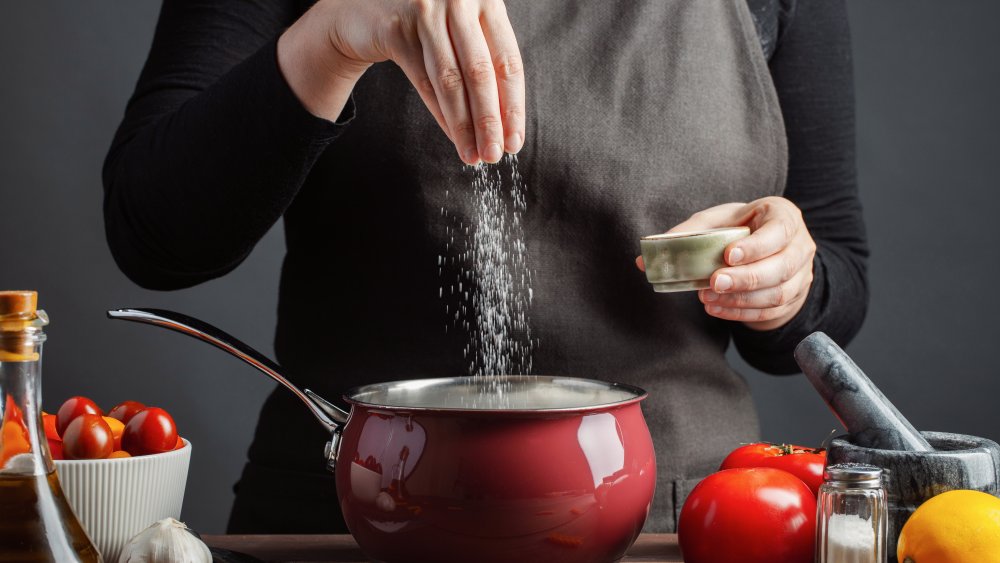The average person consumes over twice the recommended daily salt intake. The WHO has lowered its guideline to less than 2g per day (from 5g), urging healthier alternatives to reduce salt consumption globally
Published Feb 01, 2025 | 7:00 AM ⚊ Updated Feb 01, 2025 | 7:00 AM

Representative pic (Wikimedia Commons)
Do you know that the average person consumes more than double the recommended daily intake of salt? The World Health Organisation (WHO) has sounded the alarm, urging people worldwide to consume less than two grammes of salt per day – it was earlier 5g per day. WHO has also recommended healthier alternatives that could help replace or reduce salt intake.
Too much salt is linked to high blood pressure, heart disease, and strokes — leading causes of death globally.
Dr Kiran Madhala, National Coordinator, All India Federation of Government Doctors’ Association told South First: “To reduce blood pressure and the risk of cardiovascular diseases, WHO has recommended reducing sodium intake to less than 2g/per day. This is a strong recommendation. On average Indian population consumes 9.8 grammes of salt per person per day.”
Prof Vivekanand Jha, executive director of The George Institute for Global Health India said, “To fight the growing problem of hypertension and heart and kidney disease in India, especially in rural areas, we need to make the low-sodium, potassium enriched salts affordable and easily available. By working with policy makers and the food industry and educating people about their benefits with clear labelling and subsidies, we can encourage their use, save lives, and tackle India’s high salt intake for a healthier future.”
Prof Jha emphasised the need to generate evidence on the safety and efficacy of salt substitutes in special populations, such as those with kidney disease.
Dr Madhala says that using less table salt is an important part of an overall sodium reduction strategy. WHO suggests replacing regular salt with some substitutes, but Dr Madhala underlines the fact that the substitutes are meant for adults, not pregnant women or children.
People with kidney impairment or with other conditions that compromise potassium excretion should also be mindful of not using substitutes without consulting their doctor.
If you are wondering what could be used instead regular salt, here are some smart and effective substitutes recommended by WHO, which could lower health risk without compromising taste.
1. Potassium-Enriched Salt Substitutes
Why? Potassium chloride is a key alternative recommended by WHO. It mimics the taste of regular salt but can help lower blood pressure by counteracting the effects of sodium.
Good for: People looking to maintain heart health
Foods high in potassium chloride: Spinach, Beet greens, potatoes, tomatoes, mushrooms, pumpkin, zucchini, bananas, oranges, avocados, kiwi, lentils, chickpeas, soybeans, milk, yogurt, cheese, chicken, coconut water, dark chocolate etc
Caution: Not recommended for those with kidney disease or those on potassium-restricting medications.
2. Seaweed-Based Seasoning
Seaweed flakes, such as nori, dulse, and kelp, naturally contain minerals that enhance flavour without excess sodium. These are increasingly being promoted as a healthy alternative in Asian and Mediterranean cuisines.
Good for: Adding umami flavor to dishes
Caution: Check iodine levels if consumed in large amounts
3. Herbs and Spices Mixes
Fresh or dried herbs and spices like basil, rosemary, thyme, turmeric, and cumin can naturally add flavour to food without adding sodium. The WHO recommends their use to enhance taste in low-sodium diets.
Good for: Reducing dependency on salt
Caution: Some spice blends contain hidden salt — read labels carefully
4. Lemon Juice and Vinegar
The acidity in lemon juice, apple cider vinegar, and balsamic vinegar can bring out natural flavours in food, reducing the need for salt. WHO highlights their use in low-sodium meal preparation.
Good for: Salads, marinades, and cooked dishes
Caution: Excess acidity may not be suitable for people with acid reflux
5. Nutritional Yeast
This savoury, cheese-like ingredient is a WHO-endorsed alternative for adding depth to meals without increasing sodium intake. It is also rich in B vitamins.
Good for: Vegan dishes, popcorn, soups, and sauces
Caution: Some brands may have added salt — opt for unsalted varieties
6. Black Salt (Kala Namak) and Himalayan Pink Salt
While these contain sodium, they also have trace minerals that may be healthier than regular table salt. The WHO suggests their use in moderation as an alternative.
Good for: Indian and Asian cuisine
Caution: Still contains sodium, so use sparingly
7. Garlic and Onion Powder
These ingredients enhance flavour and are recognised by WHO as a good salt-free seasoning option.
Good for: Meat dishes, curries, soups, and stir-fries
Caution: Opt for powders without added salt
(Edited by Rosamma Thomas)
